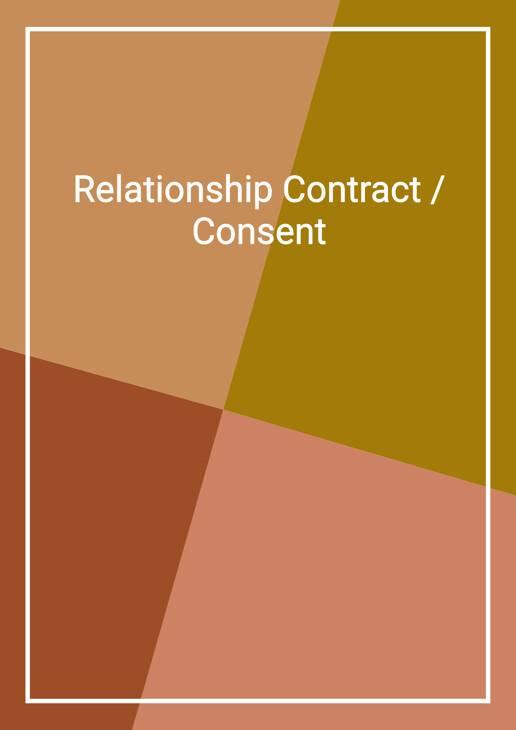
Relationship Contract / Consent
Polyamorous / Open
This document can be used as a Polyamorous / Open relationship / Friends with benefits agreement to be formally entered into by parties. This document maybe regarded as unenforceable / immoral and even illegal in certain jurisdictions. Nevertheless, this may still be used as evidence of the parties' intention to be in a polyamorous relationship.
How to Tailor the Document for Your Need?
01
Create Document
Fill in the details of the parties. You can click the "Fill with Member’s Information" button to complete it with information saved to your account.
02
Fill Information
Please fill in any additional information by following the step-by-step guide on the left hand side of the preview document and click the "Next" button.
03
Get Document
When you are done, click the "Get Document" button and you can download the document in Word or PDF format.
04
Review Document
Please get all parties to review the document carefully and make any final modifications to ensure that the details are correct before signing the document.
Document Preview
Document Description
A relationship contract (or a relationship agreement) is a mutually agreed-upon document that outlines the expectations of individuals in a romantic partnership. Many people treat this agreement as a roadmap for the relationship, hoping to avoid misunderstandings and conflicts. Although this agreement is not legally binding in court, it has a significant importance as a tool for communication and understanding between partners.
Many people hope to foster open communication and ensure they are on the same page with the aid of a a relationship contract. This document may reflect the unique dynamics and preferences of the couple, outlining the responsibilities and goals of a relationship. Generally, this document covers a series of matters such as financial arrangement, division of housework or even future aspirations. It should be, however, noted that Relationship Contract/Consent document is a legally unenforceable and potentially controversial agreement. This document may be regarded as immoral or even illegal in some places, so it barely serves the purpose of an evidence of the parties' willingness to enter into a polyamorous relationship.
The document begins by highlighting the effort required to maintain and flourish in a polyamorous relationship, which is a practice or philosophy where someone has, or is open to having, multiple loving partners simultaneously with the knowledge and consent of everyone involved. Then, it stresses the importance of satisfying intimate needs while excluding emotions such as love, jealousy, and infatuation.
The contents of a relationship contract are highly personalized and depend on the thoughts of the individuals involved. Common elements may include:
- Communication Styles: Clear guidelines on how to communicate effectively and resolve conflicts.
- Financial Arrangements: Agreements on joint expenses, individual contributions, and savings goals.
- Division of Responsibilities: Clarity on household chores, childcare, and other shared duties.
- Personal Space and Boundaries: Understanding each other's need for personal space and setting boundaries.
- Long-Term Goals: Discussions about future plans, such as career aspirations, family planning, and lifestyle choices.
The document is divided into several sections. The ground rules section establishes the main purpose of the relationship and emphasizes safety, protection, and the right to have relationships with other people. It also includes commitments to radical honesty, trust, and clear communication.
The communications section emphasizes the importance of regular and open conversations, resolving misunderstandings and insecurities without threatening the relationship. It also emphasizes the need to respect privacy and not attack each other in public or private.
The responsibilities section highlights the importance of equal responsibility in the relationship, investing in individual self-care, and taking responsibility for emotional responses and personal development. It also encourages avoiding over-reliance on the other party.
The intentions and acknowledgements section emphasizes the commitment to remain in the polyamorous relationship while caring for, respecting, and protecting each other. It acknowledges imperfections and the need for patience and understanding. It also highlights the importance of welcoming and honoring each other's emotions.
The respect and personal space section emphasizes the importance of individuality, taking time for oneself, respecting each other's privacy, and supporting each other's careers. It also emphasizes empowering each other and choosing love, honor, and respect.
The protection section addresses the use of protection in intimate activities, with the option for no protection if agreed upon by both parties.
The finances section addresses the ownership of properties, income, and expenses. It includes provisions for joint ownership, separate finances, and joint expenses.
The term and termination section establishes the duration of the contract and the option for renewal. It also allows for the review and revision of the contract.
The confidentiality section emphasizes the importance of keeping the terms of the contract and any private information confidential. It includes provisions regarding consent for recordings and public postings.
The mutual release section releases each party from obligations and liabilities related to the activities outlined in the contract.
The health and safety section includes representations regarding sexually transmitted diseases, pregnancy, and hygiene expectations.
The enforceability section addresses the validity and enforceability of the agreement, allowing for the substitution of invalid provisions.
The no rights under contracts for third parties section clarifies that individuals not party to the contract have no right to enforce its terms.
The governing law section specifies that the agreement is governed by jurisdiction state law.
The document concludes with the signatures of both parties, indicating their agreement to the terms and conditions outlined in the contract.
Whether a relationship contract is a good idea depends on the individual's preference and needs. For some couples, having a written agreement provides a sense of security and helps prevent misunderstandings. However, for others, it may seem overly formal or unnecessary. The key is open communication. If both partners are comfortable with the idea and find it beneficial for their relationship, a relationship contract can indeed contribute to a healthier and more harmonious partnership.
In conclusion, a relationship contract is a personalized agreement between partners, serving as a guide for their relationship. While not legally enforceable, it can foster communication and understanding. Whether it is a good idea totally depends on the couple's preferences and the level of formality desired in their relationship.
How to use this document?
1. Establish ground rules: Clearly define the purpose of the polyamorous relationship and establish ground rules, such as excluding emotions like love and jealousy.
2. Prioritize safety and protection: Discuss and agree upon the use of protection in intimate activities to ensure safety.
3. Allow relationships with others: Acknowledge and respect each party's right to have relationships with other people, with no explanation required.
4. Emphasize radical honesty and clear communication: Commit to regular and open conversations, resolving misunderstandings without threatening the relationship.
5. Share equal responsibility: Work towards 'win-win' situations and invest in individual self-care to bring the best selves to the relationship.
6. Set intentions and acknowledge imperfections: Commit to caring for, respecting, and protecting each other while acknowledging imperfections and being patient and loving with each other.
7. Respect personal space: Take time for oneself, respect privacy, and support each other's individual interests and careers.
8. Address protection and finances: Discuss the use of protection in intimate activities and agree on the ownership of properties, income, and expenses.
9. Establish the term and termination: Determine the duration of the contract and review and revise it as necessary.
10. Maintain confidentiality: Keep the terms of the contract and any private information confidential, respecting each other's privacy.
11. Release obligations and liabilities: Release each other from obligations and liabilities related to the activities outlined in the contract.
12. Prioritize health and safety: Represent that both parties are free from sexually transmitted diseases, pregnancy, and maintain proper hygiene.
13. Ensure enforceability: Understand that invalid provisions can be substituted with enforceable terms.
14. Clarify no rights for third parties: Recognize that individuals not party to the contract have no right to enforce its terms.
15. Follow governing law: Understand that the agreement is governed by jurisdiction state law.
16. Sign the contract: Both parties should sign the contract to indicate their agreement to the terms and conditions outlined.
Not the right document?
Don’t worry, we have thousands of documents for you to choose from:














